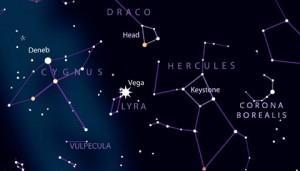The astronomical calendar says autumn arrives on September 22nd. It's a season of transition, with plenty of celestial comings and goings in the evening sky.
September’s equinox takes place on the 22nd at 10:29 p.m. Eastern Daylight Time. At that moment the Sun shines directly overhead as seen from the equator. Days and nights are both 12 hours long — that’s where the word equinox comes from — and no matter where you live the Sun rises due east and sets due west.
As darkness falls on September 1st, look for the planets Mars and Saturn to the Moon’s lower right. At month’s end, the Moon will have gone through nearly a complete cycles of phases and return to this stretch of sky. But by then Mars and Saturn will have shifted somewhat. Look for a very thin crescent Moon to Saturn’s right on the 27th. The ringed planet will soon sink from view.

Sky & Telescope diagram
Vega is right overhead at nightfall; use it to find the trapezoid-shaped head of Draco, the Dragon, about 1½ fists to Vega’s north. From there a long line of Draco's stars snakes along a curving line between the Big and Little Dippers. A second trapezoid, to the west of Vega, marks the Keystone of the constellation Hercules, a great hero in Roman mythology. Look beyond the Keystone toward west, a little more than one fist, to spot a lovely semicircle of stars called Corona Borealis, the Northern Crown.
Even if light pollution makes these groupings (and the Milky Way) difficult to see, the Summer Triangle — comprising the bright "alpha stars" Vega, Deneb, and Altair — is unmistakable overhead.
You can get more helpful guidance about stargazing in September 2014 by downloading the 6¾-minute-long audio podcast below.
And there's even more great skywatching advice in the September issue of Sky & Telescope magazine.
 0
0
Comments
You must be logged in to post a comment.